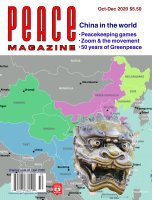
Peace Magazine Oct-Dec 2020, page 6. Some rights reserved.
Search for other articles by Jan Noel here
A grand-daddy of today’s movements, Greenpeace was founded in 1971 by twelve “eco-warriors” who ventured out in a modest boat from Vancouver to observe the US nuclear test site at Alaska’s Amchitka Island.
A small group of Canadians and Americans in Vancouver conceived the idea of navigating directly into the blast site, peacefully “bearing witness.” They had failed to persuade the Sierra Club to decry testing near a seismic fault-line. With funds raised at a folk concert, the crew headed north in a fishing boat dubbed Greenpeace. The mission failed. Stomach-churning storms, changing test dates, and crew infighting caused them to turn back. However, they had two secret weapons, which ended future Amchitka testing and made Greenpeace a name to conjure with.
The first weapon was media. Vancouver Sun journalist Robert Hunter, who accompanied that initial sailing, rose to prominence in the organization. A devotee of Marshall McLuhan, he considered media coverage even more important than the success of any particular mission. Greenpeace performed to capture the world’s eye.
The second weapon was youthful daring. They snatched the battle to save the ecosystem from the mild-mannered, middle-aged Sierra Club members, birdwatchers, and fretting readers of Silent Spring. During the 1970s a mainly male crew (“as macho as the military system they were opposing”) sailed into danger spots.
Mobilized by images of baby seals clubbed to death for furs, they alienated Newfoundland hunters who had initially been allies against industrial sealers. Greenpeacers in small boats darted towards Japanese and Russian whaling vessels, discharging harpoons and gaining international protection for truly endangered animals.
On they sailed. In 1985 about a dozen crew on Greenpeace’s Rainbow Warrior relocated some three hundred Marshall Islanders from their nuclear-contaminated atoll. They failed to block French nuclear testing in Polynesia, and French secret agents blew up the Rainbow Warrior at dock in Auckland.
New Zealand joined the vanguard of anti-nuclear activism, and other countries followed. A second Rainbow Warrior sailed to Moruroa, flanked by 25 other boats from Pacific Rim countries, to protest nuclear testing. While French commandos assaulted Rainbow Warrior and its crew, one of them filmed, then smuggled the footage in her vagina.
In later campaigns against various countries dumping nuclear wastes into oceans, activists manoeuvred frail Zodiacs alongside ships dropping toxic barrels. These bold ventures captured imaginations around the world. They led to bans; and they endowed environmentalism with images of youth and heroism against a pristine backdrop of sea and sky.
Today Greenpeace is an Amsterdam-based organization with over 3,000 employees active in 55 countries. Work often turns to securing agreements with the United Nations, the European Union, and governments. They banned CFCs, more recently provided sustainable food in schools. Campaigns against palm oil helped stop deforestation in Indonesia. Campaigns against unsafe food and fabric production and fuel wastage led to agreements with Nestle, Ikea, Zara, Primark, Best Buy, Apple and others.
Greenpeace retains its maverick reputation. A hundred Nobel laureates countered its opposition to genetically modified Golden Rice. Yet direct action fostered Antarctic protection from commodity extraction, old growth forest preserves in Canada and Russia, resistance to plastic packaging in West Africa, and international garbage dumping in the Philippines. Its Canadian website features a host of worldwide successes. Never mind if the Twittersphere flits to Extinction Rebellion and charismatic Swedish teens. Granddad has made his mark.
Jan Noel is a retired history professor, University of Toronto.

Peace Magazine Oct-Dec 2020, page 6. Some rights reserved.
Search for other articles by Jan Noel here